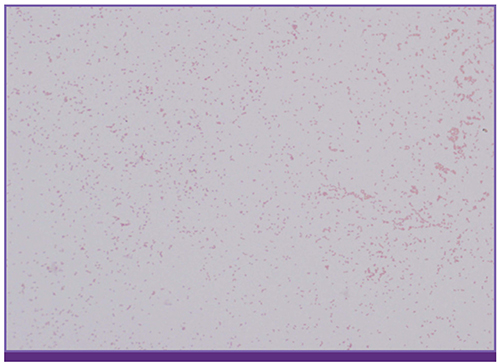Infect Chemother.
2018 Jun;50(2):149-152. 10.3947/ic.2018.50.2.149.
An Imported Case of Brucella melitensis Infection in South Korea
- Affiliations
-
- 1Department of Internal Medicine, Yonsei University College of Medicine, Seoul, Korea. seran@yuhs.ac
- 2AIDS Research Institute, Yonsei University College of Medicine, Seoul, Korea.
- 3Department of Laboratory Medicine, Yonsei University College of Medicine, Seoul, Korea.
- KMID: 2415037
- DOI: http://doi.org/10.3947/ic.2018.50.2.149
Abstract
- Brucellosis is a zoonotic infection that is usually transmitted from cattle to humans through ingestion of animal milk, direct contact with animal parts, or inhalation of aerosolized particles. In Korea, brucellosis seem to be transmitted through close contact with blood, fetus, urine, and placenta of domestic cow that has been infected by Brucella abortus, or inhalation of B. arbortus while examining or slaughtering cow. Brucella melitensis infection is rare in Korea and there have been no reported cases of B. melitensis originating from other countries until now. This report details a case of complicated brucellosis with infective spondylitis in a 48-year-old male construction worker recently returned from Iraq. Infection with B. melitensis was confirmed using 16s rRNA sequencing and omp31 gene analysis. The patient was successfully treated using a combination of rifampin, doxycycline, and streptomycin, in accordance with WHO guidelines. This is the first reported case of complicated brucellosis with infective spondylitis in Korea caused by B. melitensis originating from Iraq.
MeSH Terms
Figure
Reference
-
1. Ryu SY, Kim HA, Park J, Choe M, Kwon K. Brucella prostatitis: a first case report diagnosed in Korea. Korean J Pathol. 2011; 45:Suppl 1. S66–S69.2. Pappas G, Akritidis N, Bosilkovski M, Tsianos E. Brucellosis. N Engl J Med. 2005; 352:2325–2336.
Article3. Skalsky K, Yahav D, Bishara J, Pitlik S, Leibovici L, Paul M. Treatment of human brucellosis: systematic review and meta-analysis of randomised controlled trials. BMJ. 2008; 336:701–704.
Article4. Colmenero JD, Ruiz-Mesa JD, Plata A, Bermúdez P, Martín-Rico P, Queipo-Ortuño MI, Reguera JM. Clinical findings, therapeutic approach, and outcome of brucellar vertebral osteomyelitis. Clin Infect Dis. 2008; 46:426–433.
Article5. Lim HS, Song YG, Yoo HS, Park MY, Kim JW. Brucellosis: an overview. Korean J Epidemiol. 2005; 27:26–36.6. Guerra H. The brucellae and their success as pathogens. Crit Rev Microbiol. 2007; 33:325–331.
Article7. Jang Y, Kim H, Bang HA, Lee MJ, Che NH, Lee WC. Epidemiological aspects of human brucellosis and leptospirosis outbreaks in Korea. J Clin Med Res. 2011; 3:199–202.
Article8. Kim SH, Kim KP, Han S, Kim YR, Kang SH. A case of acute myeloid leukemia developing after treatment for brucellosis with pancytopenia. Lab Med Online. 2015; 5:157–160.
Article9. Ariza J, Bosilkovski M, Cascio A, Colmenero JD, Corbel MJ, Falagas ME, Memish ZA, Roushan MR, Rubinstein E, Sipsas NV, Solera J, Young EJ, Pappas G. International Society of Chemotherapy. Institute of Continuing Medical Education of Ioannina. Perspectives for the treatment of brucellosis in the 21st century: the Ioannina recommendations. PLoS Med. 2007; 4:e317.10. Ablon G, Dayan SA. Randomized, Double-blind, Placebo-controlled, Multi-center, Extension Trial Evaluating the Efficacy of a New Oral Supplement in Women with Self-perceived Thinning Hair. J Clin Aesthet Dermatol. 2015; 8:15–21.11. Solís García del Pozo J, Solera J. Systematic review and meta-analysis of randomized clinical trials in the treatment of human brucellosis. PLoS One. 2012; 7:e32090.
Article12. Yoon H, Moon OK, Lee SH, Lee WC, Her M, Jeong W, Jung SC, Kim DS. Epidemiology of brucellosis among cattle in Korea from 2001 to 2011. J Vet Sci. 2014; 15:537–543.
Article13. Rubach MP, Halliday JE, Cleaveland S, Crump JA. Brucellosis in low-income and middle-income countries. Curr Opin Infect Dis. 2013; 26:404–412.
Article14. Park MS, Woo YS, Lee MJ, Shim SK, Lee HK, Choi YS, Lee WH, Kim KH, Park MY. The first case of human brucellosis in Korea. Infect Chemother. 2003; 35:461–466.15. Kim YS, Sill CY, Oh WS, Kwon KT, Lee H, Lee SH, Son JS, Kim SW, Chang HH, Jung SI, Ko KS, Park MY, Peck KR, Song JH. Clinical characteristics of human brucellosis in South Korea. Infect Chemother. 2006; 38:334–343.
- Full Text Links
- Actions
-
Cited
- CITED
-
- Close
- Share
- Similar articles
-
- Identification of Brucella melitensis isolates originating from Mongolia and diagnostic real-time PCR evaluation using a specific SNP
- Interaction between Brucella melitensis 16M and small ubiquitin-related modifier 1 and E2 conjugating enzyme 9 in mouse RAW264.7 macrophages
- A Novel PCR Assay for Detecting Brucella abortus and Brucella melitensis
- Surgical Management of Cervical Spinal Epidural Abscess Caused by Brucella Melitensis : Report of Two Cases and Review of the Literature
- Brucella Epididymorchitis: A Rare Cause of Testicular Mass




